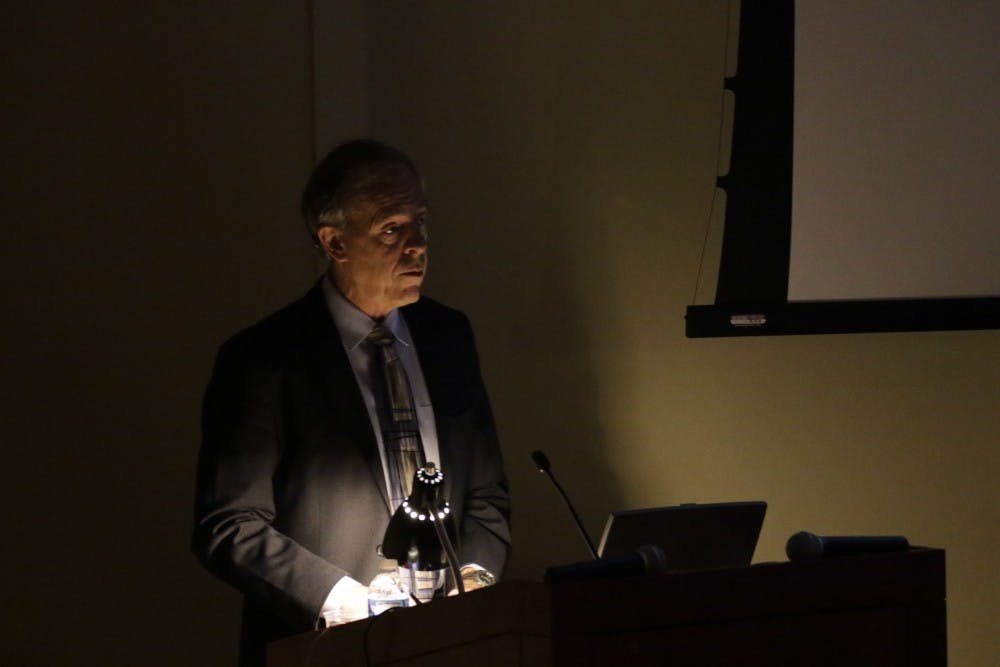History Professor Philip Morgan gave a presentation entitled “Entangled Lives: Slavery at George Washington’s Mount Vernon,” on Thursday evening in Mason Hall. The talk, illuminating the slave experience on Washington’s Mount Vernon plantation, was delivered in celebration of Black History Month by the Homewood Museum, the former country house and slave-holding farm of the Carroll.
Morgan explained how Washington became involved with slavery when he became a slave owner at age 11. He then turned attention away from Washington and focused instead on the lives of slaves at Mount Vernon.
Morgan began by describing the harsh workplace that slaves under Washington endured.
“First and foremost it was a place of unremitting toil and incessant labor,” Morgan said. “Washington was a demanding, exacting master. As he told one manager, ‘I expect my people will work from day breaking until it's dusk, enjoying the white masters and overseers to be always with the slaves, who are to be under the immediate eye of a supervisor at all times.’”
He explained that Mount Vernon’s economic orientation shifted dramatically in the 1760s from a tobacco plantation to a mixed agricultural farm, which could stand by itself as a self-sufficient estate.
“Since the later demands for grain was much less than tobacco, Washington’s slaves had to diversify. They learned to use the plow rather than the hoe, to rotate crops, plant, forage grasses, pitch and drain meadows, gather hay, reaping grains... cultivating a range of grains, oats and barleys and so on, putting up fences to corral some livestock and keep out others,” Morgan said. “The Mount Vernon slaves became some of the most skilled, multi-crop farmhands in the region.”
A large number of the Mount Vernon slaves had a specialized skill. Many became experts in animal husbandry and stockbreeding. Some became fishermen, and a large number of women turned to spinning or weaving.
Morgan then spoke about the family dynamic of slave life in Mount Vernon. Even though marriage was not legal for the enslaved, family provided a chance for respite.
“Informally, Virginia slaves constructed relationships of long-standing, that their masters tacitly recognized. Increasingly, the Mount Vernon slaves formed an intricate web of ‘kin-ties’ that Washington came to respect or at least impart,” Morgan said. “So by the end of the 18th century, two-thirds of slaves at Mount Vernon had spouses. Even though married slaves formed a majority, a minority of them, just a third, lived in the same household”
Morgan then detailed the process of escape and slaves’ resistance to the system.
“In 1786 George Washington contemplated the purchases of six slaves. One essential requirement was that none of them, as he said, ‘must be addicted to running away.’ ‘Slave flight’, he added for emphasis, ‘I abominate.’ And well he might. In the second half of the 18th century, almost 50 of his and his wife’s slaves ran away,” Morgan said.
Washington took slave flight seriously and usually adopted harsh actions to curtail it.
“[Later in Washington’s life], flight became harder, not easier, for Mount Vernon slaves,” Morgan said.
Morgan mentioned two particular instances in which Washington’s daily life was closely influenced by the lives of his slaves. He had a large collection of false teeth: some made out of ivory, some human teeth. He would occasionally buy teeth from his slaves for nine shillings a tooth.
“Washington sometimes paid attention to his slave’s teeth. Of one African, he noted, ‘his teeth straggling and filed sharp.’ In contemplating the purchase of slaves, he specified ‘good teeth’ as a requirement,” Morgan said. “And of Caesar [one of his slaves] he said, ‘his fore teeth stand out.’ And in 1784, he purchased teeth from several unnamed slaves.”
Washington also forbade his slaves from owning dogs.
“He was so concerned about the depravations on his sheep and hogs that he ordered a hostile purge. But he noticed that his slaves were bearing a new set of dogs. So he pronounced that if any slave preserve or bring a dog into the family he should be severely punished and the dog hanged,” Morgan said.
Freshman Justin Shapiro enjoyed the lecture.
“As a history major, I always try to attend history discussions above and beyond the required course work. I visited Mount Vernon, and I was curious to hear Professor Morgan’s viewpoint. I thought it was an interesting and thought-provoking lecture,” Shapiro said.
Freshman Rachel Long also expressed satisfaction with the presentation.
“It was extremely enlightening,” she wrote in an email to The News-Letter. “I... respected that he put the emphasis on the slaves, and not on George Washington himself.”





